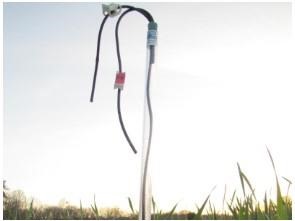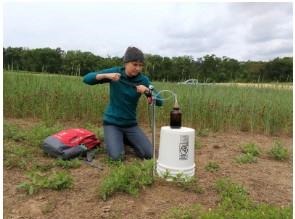By Eric Hamilton
The Chesapeake Bay once produced tens of millions of bushels of oysters a year. Today, the oyster harvest is below one percent of these historic highs.

A tension lysimeter among multi-species cover crop in early spring. This device allows researchers to collect and analyze subsurface water to see how much nitrogen it contains. Excess nitrogen in water stimulates the production of weeds and algae and affects oxygen levels, which can be harmful to aquatic life.
What happened?
“With modern farming and urban development in the watershed around the Bay during the mid-20th century, water quality declined rapidly,” says Ray Weil, a professor of soil science at the University of Maryland. “Soon the oysters disappeared, many of the fish nearly went extinct, and the crabs were threatened.”
Weil studies ways to help the Chesapeake Bay recover. His research focuses on one of the key culprits in the bay’s decline: nutrients. Key plant nutrients like nitrogen and phosphorous are good for crops, Weil says. “However, in waterways, nitrogen also stimulates the production of plants. In this case it’s aquatic weeds and algae,” he says. All that extra biomass dies and rots, removing oxygen from the water. Lack of oxygen in the waters is a major threat to life in the Chesapeake Bay. In addition, some algae can be toxic to people and fish.
Weil's study was published in Journal of Environmental Quality, a publication of the American Society of Agronomy, Crop Science Society of America, and Soil Science Society of America.

Shelly Porter, undergraduate research assistant, applies a vacuum to a tension lysimeter to sample water leached during the previous 24 hours. The sample includes water and dissolved nutrients that had already drained below the crop rooting depth, which would eventually end up in groundwater and then the Chesapeake Bay. The use of cover crops helps keep nitrogen out of groundwater.
While the Chesapeake Bay has lost some of its luster due to nutrient challenges, it still provides many benefits to nearby residents. It is the second largest estuary — a habitat of brackish water — in the world. The bay itself is roughly 200 miles long. But its watershed covers 64,000 square miles across six states and Washington, D.C. About 500 million pounds of seafood are harvested from the Bay each year. The habitat also cleans water while providing breeding grounds for important wildlife.
To help their struggling waterway, Maryland residents voted to tax themselves to provide incentives to farmers to grow cover crops. These are crops that farmers do not sell, but can hold onto excess nitrogen, keeping it out of waterways.
In Weil’s latest research, he studied how the timing of cover crop growth affected their ability to keep nitrogen out of the Chesapeake Bay water. Cover crops are typically planted late in the year after farmers have harvested their cash crops. However, his lab’s previous research indicated that this was probably too late for cover crops to be effective in capturing nitrogen. The key metric is how much nitrogen drains through the soil to groundwater; a process known as leaching.
Click here to see more...